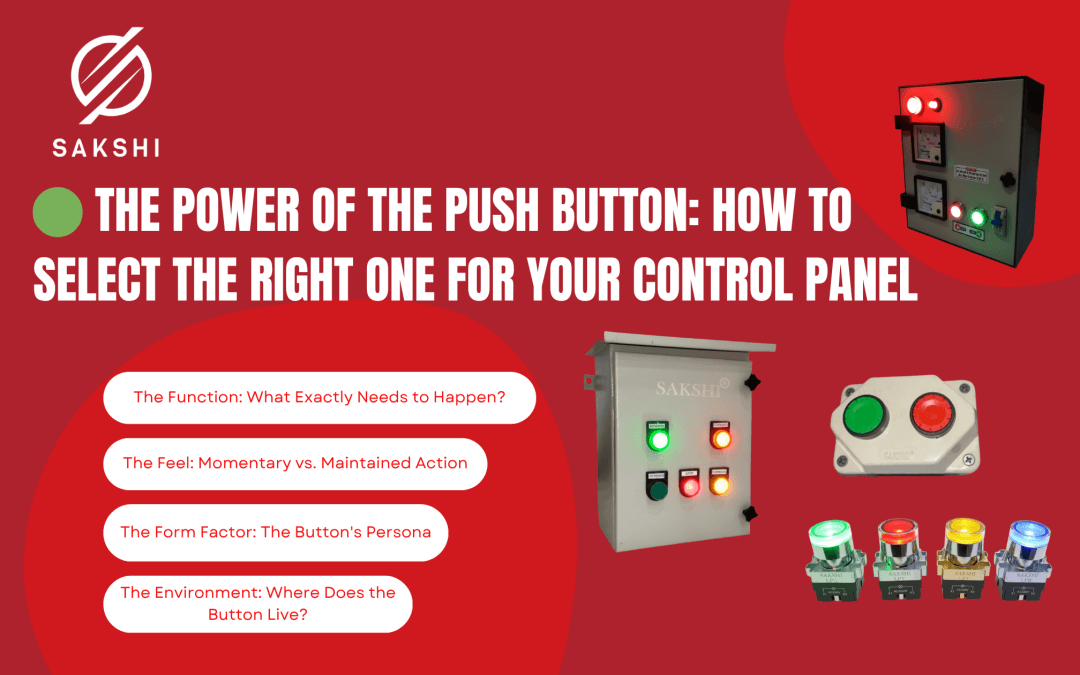They are small, they are simple, and they are the frontline soldiers of your entire control system. We’re talking about the humble, yet mighty, push button.
In the world of industrial control panels, a push button isn’t just a switch; it’s the critical human-machine interface. A reliable push button ensures a machine starts when it should, stops when it must, and prevents operators from accidentally turning a complex process into a complex catastrophe.
Choosing the right button isn’t about picking your favorite color. It’s about safety, durability, and functionality. Here is a guide from Dhiraj Electrical India on how to select the perfect push button for your critical control panel.
1. The Function: What Exactly Needs to Happen?
Before you choose the button’s shape, you need to define its action. This is determined by the internal contacts:
- Normally Open (NO): The circuit is open (power off) in its resting state. Pushing the button closes the circuit (power on).
- Typical Use: START buttons, activating a pump, or turning on an indicator light.
- Normally Closed (NC): The circuit is closed (power on) in its resting state. Pushing the button opens the circuit (power off).
- Typical Use: STOP buttons, cutting power to a motor, or activating a safety mechanism.
💡 Pro Tip: Many critical applications, like a two-hand safety control, require NO/NC combinations (often called “Form C” or “SPDT” contacts) to ensure redundant safety measures.
2. The Feel: Momentary vs. Maintained Action
How long does the action need to last?
- Momentary (The Sprinter): The contact changes state only while the button is pressed. As soon as the operator removes their finger, the contact snaps back to its original state.
- Use: Jogging a motor, starting a sequence, or any simple on/off command.
- Maintained (The Marathoner): The contact changes state when pressed and stays in that position until the button is pressed again (often seen in selector switches or latching buttons).
- Use: Choosing operating modes (e.g., Manual vs. Automatic), or a permanent light switch.
3. The Form Factor: The Button’s Persona
The button’s appearance is often dictated by the need for quick identification and safety.
| Type | Appearance | Common Use |
| Flush | Flat, does not protrude much. | Standard start/stop controls where accidental operation is less of a risk. |
| Extended/Mushroom | Head sticks out prominently. | STOP or Emergency functions where quick, easy striking is necessary. |
| Illuminated | Has an integrated LED/lamp. | Used to provide feedback: green for “System Running,” red for “Fault,” or when the machine is ready. |
| Selector Switch | Rotates rather than pushes. | Choosing operating conditions (e.g., Speed 1, Speed 2, Off). |
The All-Important E-STOP (Emergency Stop)
The Emergency Stop button is non-negotiable for safety. It must be a prominent Red Mushroom Head with a latching (maintained) action that requires a deliberate pull or twist to reset. It must be accessible, immediately recognizable, and directly wired to cut power (NC contact).
4. The Environment: Where Does the Button Live?
A button used indoors in a clean room is very different from one mounted outside on a cement mixer. You need to consider the Ingress Protection (IP) rating:
- IP65: Common for indoor panels. Protects against dust and low-pressure water jets.
- IP66 / IP67: Essential for outdoor or washdown areas. Offers protection against strong water jets or even temporary submersion.
Always ensure the button’s material is appropriate. If exposed to chemicals or harsh UV light, you need durable plastic or stainless steel, not standard ABS.
⚙️ Why Choose Dhiraj Electrical Push Buttons?
We understand that control panels are the brain of your operation. That’s why we specialize in supplying high-quality, durable push buttons, including our trusted Sakshi push buttons for panels. Our range ensures reliable NO/NC contacts and robust construction built to withstand the rigorous demands of industrial use.
Don’t let a faulty, cheap component compromise your entire system. Invest in the right interface—invest in the power of a quality push button.
Would you like me to suggest the three most popular push button types for a typical industrial motor control center?



